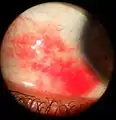Subconjunctival bleeding
Subconjunctival bleeding, also known as subconjunctival hemorrhage or subconjunctival haemorrhage, is bleeding from a small blood vessel over the whites of the eye.[1] It results in a red spot in the white of the eye.[1] There is generally little to no pain and vision is not affected.[2][3] Generally only one eye is affected.[2]
| Subconjunctival bleeding | |
|---|---|
| Other names | Subconjunctival hemorrhage, subconjunctival haemorrhage, hyposphagma |
 | |
| Subconjunctival hemorrhage resulting in red coloration of the white of the eye. | |
| Specialty | Ophthalmology |
| Symptoms | Red spot over whites of the eye, little to no pain[1] |
| Complications | None[2] |
| Duration | Two to three weeks[2] |
| Types | Traumatic, spontaneous[2] |
| Causes | Coughing, vomiting, direct injury[2] |
| Risk factors | High blood pressure, diabetes, older age[2] |
| Diagnostic method | Based on the appearance[2] |
| Differential diagnosis | Open globe, retrobulbar hematoma, conjunctivitis, pterygium[2] |
| Treatment | No specific treatment[3] |
| Medication | Artificial tears[2] |
| Prognosis | Good, 10% risk of reoccurance[2] |
| Frequency | Common[4] |
Causes can include coughing, vomiting, heavy lifting, and direct injury including that from wearing contact lenses.[2] Risk factors include high blood pressure, diabetes, older age, blood thinners, and trauma including that from wearing contact lenses.[2] They occur in about 2% of newborns following a vaginal delivery.[2] The blood occurs between the conjunctiva and the episclera.[2] Diagnosis is generally based on the appearance.[2]
Generally no specific treatment is required and the condition improves in two to three weeks.[2] Artificial tears may be used to help with any irritation.[2] They occur relatively commonly.[4] Both sexes are affected equally.[2] Spontaneous bleeding occurs more commonly over the age of 50 while the traumatic type occurs more often in young males.[2]
Signs and symptoms
A subconjunctival bleeding usually does not result in pain, although occasionally the affected eye may feel dry, rough, or scratchy.
A subconjunctival bleeding initially appears bright-red underneath the transparent conjunctiva. Later, the bleeding may spread and become green or yellow as the hemoglobin is metabolized. It usually disappears within 2 weeks.[5]
.jpg.webp) After one week
After one week.jpg.webp) Same as prior after four weeks
Same as prior after four weeks As viewed through a slit lamp
As viewed through a slit lamp After 48 hours
After 48 hours
Causes
- It may result from being choked
- Certain infections of the outside of the eye (conjunctivitis) where a virus or a bacteria weaken the walls of small blood vessels under the conjunctiva
- Mask squeeze from diving and not equalizing mask pressure during descent
- Eye trauma
- Coagulation disorder (congenital or acquired) including Ebola
- Head injury
- Whooping cough or other extreme sneezing or coughing[6]
- Severe hypertension
- LASIK
- Acute hemorrhagic conjunctivitis (caused by Enterovirus 70 or Coxsackie A virus)
- Leptospirosis
- Increased venous pressure (e.g., extreme g-force, straining, vomiting, choking, or coughing)[6][7] or from straining due to constipation
- Zygoma fracture (results in lateral subconjunctival bleeding)
Subconjunctival bleeding in infants may be associated with scurvy (a vitamin C deficiency),[8][9] abuse or traumatic asphyxia syndrome.[10]
Eye surgery such as LASIK, and atmospheric pressure changes such as those from diving deeply in water and aircraft altitude changes.[6][7]
Diagnosis
Diagnosis is by visual inspection, by noting the typical finding of bright red discoloration confined to the white portion (sclera) of the eye.
Management
A subconjunctival bleeding is typically a self-limiting condition that requires no treatment unless there is evidence of an eye infection or there has been significant eye trauma. Artificial tears may be applied four to six times a day if the eye feels dry or scratchy.[11] The elective use of aspirin is typically discouraged.
References
- "What is a Subconjunctival Hemorrhage?". American Academy of Ophthalmology. 3 July 2019. Retrieved 17 October 2019.
- Doshi, R; Noohani, T (January 2020). "Subconjunctival Hemorrhage". PMID 31869130. Cite journal requires
|journal=(help) - Cronau, H; Kankanala, RR; Mauger, T (15 January 2010). "Diagnosis and management of red eye in primary care". American Family Physician. 81 (2): 137–44. PMID 20082509.
- Gold, Daniel H.; Lewis, Richard Alan (2010). Clinical Eye Atlas. Oxford University Press. p. 82. ISBN 978-0-19-534217-8.
- Robert H. Grahamn (February 2009). "Subconjunctival Hemorrhage". emedicine.com. Retrieved 23 November 2010.
- "Subconjunctival hemorrhage". PubMed Health on the National Institutes of Health website. May 1, 2011. Retrieved October 15, 2012.
- "Subconjunctival hemorrhage". Disease.com. n.d. Retrieved October 15, 2012.
- "Möller-Barlow disease". whonamedit.com. Retrieved 23 November 2010.
- Bruce M. Rothschild (December 17, 2008). "Scurvy". eMedicine.com. Retrieved 23 November 2010.
- Spitzer S. G; Luorno J.; Noël L. P. (2005). "Isolated subconjunctival hemorrhages in nonaccidental trauma". Journal of American Association for Pediatric Ophthalmology and Strabismus. 9 (1): 53–56. doi:10.1016/j.jaapos.2004.10.003. PMID 15729281.
- Robert H. Grahamn (February 2009). "Subconjunctival Hemorrhage". emedicine.com. Retrieved 23 November 2010.
External links
| Classification | |
|---|---|
| External resources |
| Wikimedia Commons has media related to Subconjunctival hemorrhage. |